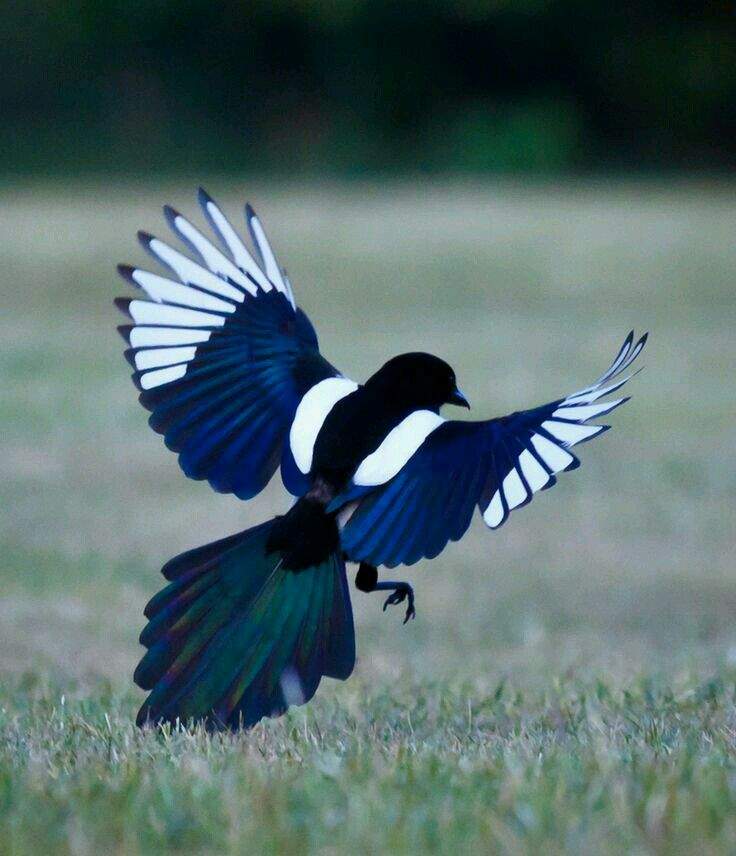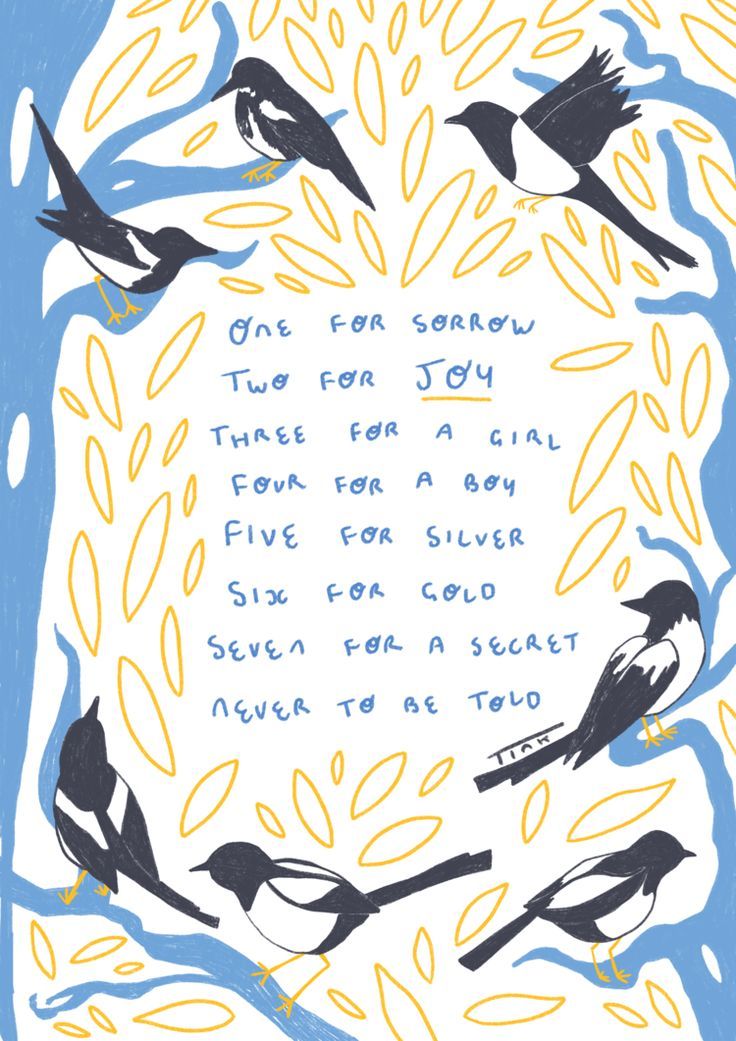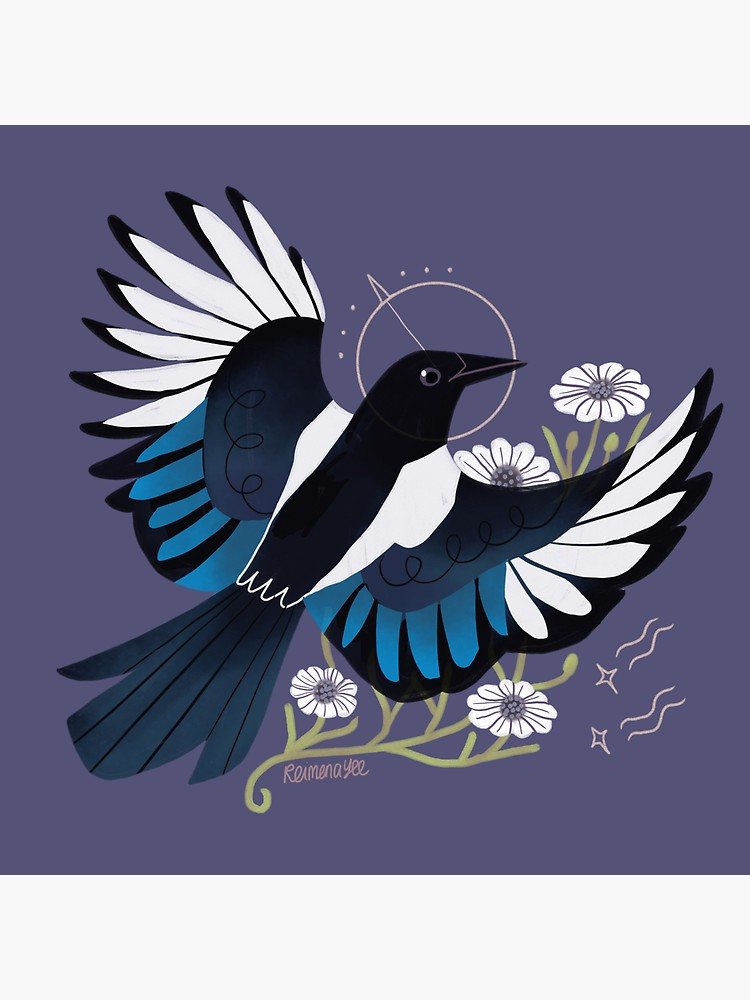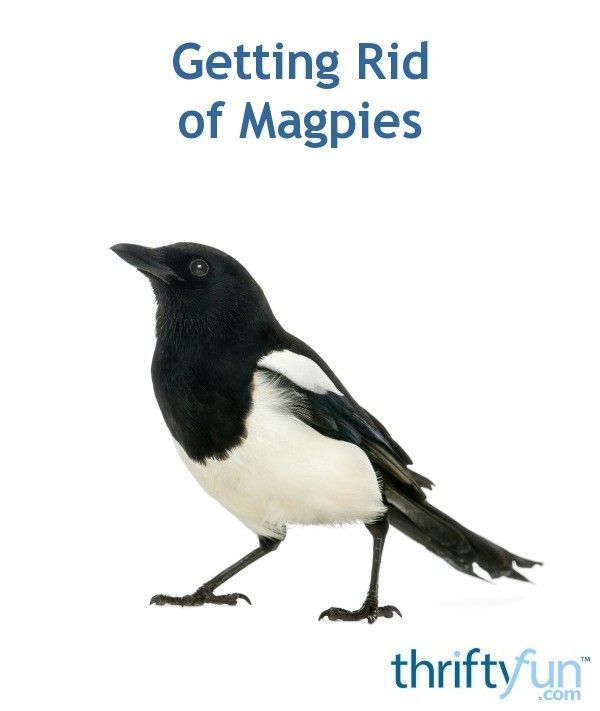Feeding baby magpies
Magpies | Wildlife Hospital
Hatchling/nestling magpies
-
Keep a little cooler than other chicks at 29.4-32.2°C.
-
Feed every 30 minutes from 7.00am - 9.00pm.
-
House chicks in a margarine container lined with toilet or tissue paper.
-
When pin feathers appear feed chicks every 30-45 minutes from 8.00am - 8.00pm.
Pre-fledgling & fledgling magpies
-
Feed pre-fledgling magpies every 45 minutes and fledgling magpies every 2 hours.
-
House older chicks in a cardboard box with a plastic screen window. Line the box with a towel and a pillowcase over it. Use a towel rolled into a donut shape as a nest.
-
Place the box near a window, so that the chicks can see other birds.
-
Place natural perches like small branches in the box.
-
When the chicks can perch and sample food, progress to a pre-flight cage (larger parrot sized cage).
Line the cage with cardboard and/or window screen lining.
-
Chicks should be self-feeding before going to an aviary.
Young magpie diet
Ingredients
-
1 cup Hill's Science Diet Canine Growth kibble soaked in 1 cup of cold water
-
1 4oz (112g) baby banana or 4oz ripe banana
-
1 peeled hard boiled egg
-
1 teaspoon of bird vitamins
-
1 teaspoon (approximately 1,800mg) ground calcium carbonate
Preparation
Mash the kibble with a fork after the water has been absorbed. Puree the egg and the banana in a blender. Mix all the ingredients in a food processor. Freeze in small containers. Thaw enough for 1 day. Warm the mixture by placing in a warm water bath.
Adult magpie diet
Ingredients
-
4 cups of Hill's Science Diet Canine Growth kibble soaked in 2 cups of cold water
-
1 teaspoon of bird vitamins
-
½ hard boiled egg
-
⅙ cup of fruit e.
 g. apple and/or pear
g. apple and/or pear -
⅙ cup of green vegetables e.g. zucchini and/or cucumber
-
⅙ cup of yellow or orange vegetables e.g. carrots and/or squash
Preparation
Mash the soaked kibble. In a food processor, pulse chop egg, fruit and vegetables until they are coarsely chopped. Mix all the ingredients together. Can be stored in a refrigerator for up to 2 days.
Magpies natural diet
Magpies mainly eat insects, worms, spiders, lizards, mice and seed. The ability to forage is important for magpies, so introduce fledglings to this by:
-
sprinkling wiggly worms on fruits, kibble and other food items
-
place bright coloured items like corn in their enclosure as this can inspire probing beaks
-
place nuts in their enclosure as they can learn to crack these open.
Feeding Australian Magpies - Tips to Keep Magpies Happy & Healthy – The Magpie Whisperer
Feeding wild birds like magpies is a topic that many animal lovers are passionate about, and while it can be controversial, there are ways to do it safely and responsibly.
While we may have good intentions, in certain situations, feeding magpies inappropriate food such as bread and plain mince can actually cause more harm than good. As magpie parents feed their nestlings a great deal of what people feed them, it's crucial that we provide them with the right nutrients to ensure their nestlings grow up strong and healthy, free from debilitating abnormalities like soft or broken beaks, bone abnormalities, deformities, seizures, and poor feather growth.
By taking the time to find the right foods to feed wild birds, we can help ensure that they are healthy, happy, and able to live their lives to the fullest. It may take a little extra effort, but the rewards are well worth it!
Magpies require a balanced and appropriate diet, just like all living creatures, to maintain their health and wellbeing. For nestlings, in particular, proper nutrition is essential for the development of their beaks, bones, and feathers.
Although some people may argue that magpies can survive on almost anything, it's important to note that improper nutrition can have long-term effects on their health and quality of life. As a licensed wildlife carer who specialises in caring for magpies, I have seen firsthand the detrimental effects of feeding them inappropriate food. In many cases, these effects can be prevented by simply providing the correct nutrients.
As a licensed wildlife carer who specialises in caring for magpies, I have seen firsthand the detrimental effects of feeding them inappropriate food. In many cases, these effects can be prevented by simply providing the correct nutrients.
Inadequate protein intake can result in poor feather quality, as feathers are mostly made up of keratin, which is a protein. Without enough protein, feathers can become brittle, break easily, and lack the necessary strength to maintain their shape and function properly. Additionally, insufficient protein can lead to reduced growth rates, particularly in young magpies. Proper nutrition is crucial during the early stages of life, as this is when birds are growing rapidly and developing important structures such as their beaks, bones, and feathers. If young magpies do not receive enough protein in their diet, they may not reach their full growth potential, which can have a negative impact on their overall health and wellbeing.
If you choose to feed magpies meat, it's crucial to select human-grade meat and supplement it with the appropriate nutrients. Supplements like Wombaroo insectivore mix or Insecta Pro can be purchased from pet stores or online. These supplements are formulated to provide insect-eating birds with the necessary nutrition they need. They are designed to mimic the nutritional content of insects, which are a natural and essential part of the magpie's diet.
Supplements like Wombaroo insectivore mix or Insecta Pro can be purchased from pet stores or online. These supplements are formulated to provide insect-eating birds with the necessary nutrition they need. They are designed to mimic the nutritional content of insects, which are a natural and essential part of the magpie's diet.
It's essential to note that magpies may take some time to become accustomed to the taste of these added supplements. To avoid any negative reactions, it's best to start with small amounts that the magpie won't notice and gradually increase to the recommended dosage. This approach will give your magpies time to adjust to the new taste and texture of the supplement, and help prevent them from rejecting it altogether. To ensure the even distribution of the supplement throughout the food, it's also a good idea to mix it thoroughly with the protein source.
Calcium plays a crucial role in strengthening magpies' bones and beaks. In addition to supplements, sources of calcium such as pulverised eggshells and cuttlefish bone can also be provided.
If you're considering feeding magpies and other wild birds, it's important to keep in mind which foods are not suitable for them. Bread, for example, should be avoided as it lacks essential nutrients and can even cause birth defects in nestlings.
Another food to be cautious about is plain mince, which contains high levels of phosphate that can result in calcium loss from magpies' beaks and bones. Raw meat is also not recommended since it can expose them to parasitic diseases like Toxoplasma gondii, which can be potentially harmful. Freezing the meat for at least three days before feeding it to magpies is crucial to ensure that the parasite is not transmitted.
Beak rot is a serious condition that can occur in magpies when they are fed mushy meat. The trapped meat inside and around the edges of their beaks can create a breeding ground for harmful bacteria to grow. Over time, this bacteria buildup can weaken the beak, making it more susceptible to breakage or other deformities.
Giving magpies chocolate should be avoided at all costs, as it contains a dangerous substance called theobromine, which can be toxic to many animals, including magpies. Even small amounts of chocolate can cause vomiting, diarrhea, seizures, and even death in these birds.
Additionally, any type of alcohol or caffeine should never be given to magpies, as it can cause liver damage, dehydration, and even death. It's crucial to provide them with safe and nutritious food that is suitable for their dietary needs.
Looking for natural and healthy alternatives to feed magpies? You don't have to look any further than your own backyard! These birds are natural foragers, and they love nothing more than digging around in the dirt and hunting for tasty treats.
Below - Magpies feasting on slaters (woodlice).
.
You can easily find 100% all-natural treats for these birds by digging up some worms, turning over rocks and logs, or stripping bark from trees. This not only gives them the essential nutrition they require but also serves as a source of entertainment and stimulation for the birds.
This not only gives them the essential nutrition they require but also serves as a source of entertainment and stimulation for the birds.
In case you don't have the opportunity to find natural treats for magpies, you may still be able to provide them with the nutrition they need by buying mealworms from your local pet supply store or online, or even breeding your own.
By gut-loading the insects before feeding them to the birds, you can increase their nutrient content and ensure that magpies receive all the necessary nutrients they require. Some of the best foods for gut-loading insects include fresh fruits and vegetables, such as leafy greens, carrots, and sweet potatoes. These foods are rich in essential vitamins, minerals, and antioxidants that will help support the overall health of the insects and the magpies that consume them.
You can also purchase an insect booster. This booster can be fed to the insects for a period of 7 to 14 days before feeding them to the birds. By doing this, the nutrients in the insects' body tissue are enhanced, making them even more beneficial for the birds to consume. The booster contains a special blend of nutrients that are designed to improve the insects' overall health and nutritional value, which in turn, will benefit the health and wellbeing of the magpies.
By doing this, the nutrients in the insects' body tissue are enhanced, making them even more beneficial for the birds to consume. The booster contains a special blend of nutrients that are designed to improve the insects' overall health and nutritional value, which in turn, will benefit the health and wellbeing of the magpies.
For more information on how to feed magpies and other wild birds, be sure to check out the feeding guidelines on the Wombaroo website. With the right foods and a little bit of effort, you can help these amazing creatures thrive and live their best lives in the wild!
When feeding magpies, it's important to be mindful of their behaviours and avoid creating routines that could lead to dependency on human-provided food. Magpies are intelligent birds that can quickly learn routines and habits, which means feeding them at a set time every day could create a situation where they wait around for food and become overly reliant on humans for nourishment.
To prevent this from happening, it's recommended to feed magpies at varying intervals rather than at a consistent time each day. This can prevent them from developing a routine and encourage them to continue foraging for their own food, which is an important part of their natural behaviours.
This can prevent them from developing a routine and encourage them to continue foraging for their own food, which is an important part of their natural behaviours.
It's also important to feed magpies in moderation to avoid overreliance on human-provided food. While feeding magpies can be a pleasurable and rewarding activity, it's essential to remember that feeding them should not replace their natural food sources or interfere with their natural behaviours.
What to feed a magpie in captivity. Animal feed, vegetables, fruits
Contents
Feeding magpies in captivity is based on the general principles of feeding corvids, which can be read in a separate article "Feeding Corvids". Long-term observations of keeping these corvids in captivity inspired me to write a separate article on feeding magpies.
author of the title photo of the magpie Vasily Kalinin
Few people think about how easy it is to provide the magpie with everything necessary in captivity. As a result, there is a picture of the survival of these beautiful birds in the hands of the owners, lisping sick birds.
In this article I would like to draw the attention of corvid lovers to the fact that magpie is an active predator and gatherer. It feeds on everything it can get - from berries to fairly large animals and birds, as well as carrion.
This is true both for the nominal species Common magpie ( Pica pica ) with all subspecies, and for blue magpie ( Cyanopica cyanus ) and ecotic magpies, for example - Thick-billed azure 0009 (Urocissa caerulea ).
Feeding magpies is different from feeding adult birds, so if you picked up a magpie chick, then detailed information on how to feed the chicks is given in this article: "Feeding magpie chicks, crows, jays, jackdaws, rooks, ravens, chicks. "
"
So, what should be in the diet of forty?
The diet of forty must include
insects .Mealworm, zofobas, crickets, grasshoppers, bears, etc.
Forage insects should be bred on a variety of nutritional diets, then their nutritional value will be high. Zofobas and flour worm, grown on poor diets, is rich in fats and poor in mineral composition and vitamins. Feeding forty only with such “fatty” feeds will lead to the development of pathologies of the liver and kidneys of the bird.
During the period of mass departure of the May beetle (beetle) ( Melolontha melolontha ) it should be given to magpies without restrictions. At this time, it can be stored by freezing. Although, often, the birds quickly gorge themselves on the May beetle, especially defrosted, and refuse to eat it - in this case, you need to take breaks with his dacha.
Magpie eats "ant eggs" - ant pupae. Ant egg is very rich in nutrients, but I would not recommend introducing it into the diet of magpies on an ongoing basis - since collecting an ant egg causes great harm to anthills and, accordingly, to the forest ecosystem.
In this video, a magpie is eating a thrush. Perhaps this magpie found a thrush that had already crashed, maybe she caught it herself. Magpies are able to catch both adult birds and fledglings of sparrows, tits, and pigeons.
At home, magpies must be constantly provided with small fodder birds.
The best option is quail carcasses. You can buy gutted quails in supermarkets or you can order quails at forage farms. It is preferable to feed magpies with quails rather than chickens, since it is important that magpies receive full-fledged small bird bones rich in calcium. Chickens contain a lot of phosphorus, but little calcium.
It is not recommended to feed forty meat to broiler chickens - as such chickens are raised with various biological additives that accelerate the development of muscle tissue and these compounds are stored in raw meat. Forty such additives are not at all useful.
Common magpie preys on a rabbit. Here you can see how magpies act as regulators of the number of small animals in cities. When the populations of natural predators (wolves, foxes, dogs) decrease, small animals, in particular rabbits, actively breed.
When the populations of natural predators (wolves, foxes, dogs) decrease, small animals, in particular rabbits, actively breed.
A magpie hunts a rat. This video is specially added for those who like to blame forty in various sins and destroy them. Magpies are an important regulator of the number of rodents in cities.
Magpie hunting mice. A similar video, only here the moment of the magpie hunting for mice is captured.
Magpies at home should regularly receive small rodents.
This is critical for mineral metabolism. In magpies, it is very intense and the lack of readily available calcium in the diet quickly leads to problems with the bone tissue of birds and with the work of the heart muscle. In addition, it is important not to forget that the mechanism of pellet formation for corvids is as important as for birds of prey and owls.
Nude (nude) mice are not recommended in large quantities, as they contain a large amount of phosphorus and a small amount of calcium. This will lead to calcium deficiency in the body of the bird and the development of serious problems.
This will lead to calcium deficiency in the body of the bird and the development of serious problems.
A clip about the diet of blue magpies, if you remove the sound, it shows a variety of insects eaten by magpies. You can clearly see how healthy blue magpies look and how they move.
It may seem strange from the outside, but a huge problem for corvid lovers, as well as parrot lovers, is that people do not know what healthy birds of the species that they keep at home look like. Hence a large number of chronically ill birds that have not been dealt with for years.
Magpies prey on patterned snake ( Elaphe dione ). Although most likely, this video captures the moment of guarding the nesting area of Magpies.
Common magpie caught a snake.
Thick-billed azure magpie ( Urocissa caerulea ) hunts a snake. I don't know the type of snake. I believe that in this case, the moment of protection of the nesting site of magpies was captured on video. Snakes and lizards are part of the regular diet of these corvids.
Snakes and lizards are part of the regular diet of these corvids.
Should lizards and snakes be given to magpies? Where can I get them other than to withdraw from nature? Unless you accidentally stumble upon a snake-snake or a lizard, just crushed on a country road by a car. As a treat, it is a good addition to the diet of captive magpies. Catching reptiles specifically to feed the corvid that you have removed from nature, in my opinion, is ethically wrong and biologically criminal.
Blue magpies feed on privet berries.
All magpies should be given the maximum variety of berries available in your area.
Berries should be given both fresh and dried and frozen. Fruit should also always be present in the diets of forty.
Magpies feed on a fallen hare. Rabbit carcasses can be bought in supermarkets or from farmers. It is desirable to give them not gutted. For magpies, like any other corvids, it is very important to “load” the beak correctly so that it does not outgrow.
If you are a completely “correct” naturalist, then having a magpie, most likely you will bring home downed cats, pigeons, etc. I absolutely do not recommend doing this! since rabies, different strains of influenza, tuberculosis and many other dangerous infections are not an invention of doctors and laboratories, but a real danger to your health.
A very important point, which is overlooked and not discussed with disgust by city lovers of corvids — magpies, ravens, ravens are natural orderlies of ecotopes. An important part of their diets is made up of dead animals. Moreover, it is also important that by eating carrion, magpies get a large amount of fermented adipose and muscle tissue. These compounds cannot be replaced with artificial additives in the diet of birds, but you can not throw out the uneaten remains of mice, rats, quails from the aviary or bird room - leave them for several days in a cage or in a “stash” with a magpie.
I think that all owners of corvids understand well what a "stash" is) - these are products that turn out to be hidden in the most unexpected places. It’s good when it’s a nut, an acorn or a harmless quail egg, worse when it’s a fish head or a rat carcass hidden in a jeans pocket). If the aviary is outdoors, this is not a big problem, but at home it is more difficult. The long tubular bones of animals are well suited for such “feeding” - the magpie will be long and happy to hammer the odorous bone.
It’s good when it’s a nut, an acorn or a harmless quail egg, worse when it’s a fish head or a rat carcass hidden in a jeans pocket). If the aviary is outdoors, this is not a big problem, but at home it is more difficult. The long tubular bones of animals are well suited for such “feeding” - the magpie will be long and happy to hammer the odorous bone.
During the ripening season of nuts, acorns, chestnuts - these products are actively eaten and stored by magpies. Don't forget to provide them for your birds. This is a very good natural beak grinder.
I remind you that clay is just as important for corvids as it is for all other birds. Magpies should always have access to clay, you'd be surprised how much they eat. You can read more in the article: Clay in the diets of birds.
Conclusion, the diet of forty must necessarily include:
Insects:
mealworm, zofobas, crickets, grasshoppers, cockchafer and other available insects.
Animal carcasses:
quails, rats, mice, rabbits.
"Fermented protein"
rotten remains of feed animals or tubular bones of cattle and small cattle.
Nuts, acorns, chestnuts.
Berries. Fruits. Vegetables
Clay.
Questions - Answers about feeding forty.
V. — can magpies have mushrooms? And if possible, which ones? I gave my magpie sulfur-yellow tinder fungus, white, boletus, chanterelles in small quantities, there were no problems, but suddenly.
O. - you can. Everything edible for humans is definitely possible. All the rest are questionable, not everything that is dangerous for mammals is dangerous for birds. But I myself cannot yet say which inedible mushrooms are needed and safe for birds, I have little information about this at the moment.
Blue magpies feed on ripe persimmons.
Q. — I give chicken meat-liver-ventricles-hearts-heads-paws, but I buy only domestic chickens. By the way, when I give the whole fish, the brain and eyes are also eaten at once. Shrimp eat it too.
By the way, when I give the whole fish, the brain and eyes are also eaten at once. Shrimp eat it too.
The article has not yet said about cottage cheese in the diet, but, probably, this is because it is mentioned in other articles.) Well, about eggs. I give boiled chicken (together with the shell), and raw quail (also with the shell).
Is lean beef good for a magpie? I trim the fat. Another beef heart is quickly eaten.
A. - it's very good that you feed your magpie so varied. I did not focus on fish / meat / eggs in this article - since the basis of the magpie diet is common to all corvids. This is described in detail in the article - Nutrition of corvids. There is a discussion of the fat content of cottage cheese in the diets of corvids in the article: “What cottage cheese should be given to corvids, fat-free or normal?” Lean beef, suitable - better on the bones - for the bird to apply force in the process of eating. Beef heart is very useful for all corvids.
Q. - I would also add shellfish to the article, especially snails, which in nature make up a significant part of the diet of magpies. They eat large quantities of both slugs and snails along with shells. Empty shells are also willingly eaten and played with.
Another question about chicken heads: can I give or not? I give periodically - it is eaten completely, with the exception of the beak. Moreover, they usually immediately eat out the eyes, and then give the head a couple of days to lie down, only after that they eat it.
A. - shellfish and snails are a good source of protein and calcium, but for domestic corvids I would not recommend using "wild" snails. Mollusks are a natural "reservoir" and intermediate hosts of a large number of helminths and protozoan parasites of birds. Therefore, is better to use adjustable snails.
Chicken heads - the same trouble with them as with chickens in general - if these are chickens from your farm - everything is ok. If broilers, I would not recommend using them for feeding corvids and birds of prey.
If broilers, I would not recommend using them for feeding corvids and birds of prey.
As a reminder: a course of anthelmintics is recommended for all corvids twice a year. Late autumn and early summer.
Questions were asked by: Golub Obivanov, Lida Danish , Ekaterina Shamrock ,
As usual, I will be glad to any additions, comments, discussions.
How to feed the found chick, how many times a day
If you find a chick, the first thing you need to do is determine its species. Feeding granivorous, insectivorous and predatory chicks have their own differences. But in the early stages of feeding, you can use the same feeding methods, and then, after finding out what kind of bird you found, transfer the chick to the appropriate feeding.
Here is one of the most common feeding options for granivorous and insectivorous chicks. This nutrient mixture is well used for feeding for chicks and fledglings from the passerine family. To prepare our mixture, we need the following products: Boiled egg, low-fat cottage cheese, raw carrots, meat (beef, chicken, turkey), greens (lettuce, dandelion leaves, wood lice), hamarus and daphnia, Calcium gluconate (shell from boiled eggs) glycerophosphate , children's dry dairy-free porridge or boiled millet (without salt and fat on the water).
To prepare our mixture, we need the following products: Boiled egg, low-fat cottage cheese, raw carrots, meat (beef, chicken, turkey), greens (lettuce, dandelion leaves, wood lice), hamarus and daphnia, Calcium gluconate (shell from boiled eggs) glycerophosphate , children's dry dairy-free porridge or boiled millet (without salt and fat on the water).
Action one. Boil the egg, free from the shell. We free the shell from the shell film. Grind the egg as much as possible, you can use a grater with small holes.
Second step. Boiled meat, it is better to take the pulp from the breast of a turkey or chicken and also chop or divide into fibers. The mixture will require meat 40 (for granivorous) and 60 grams (for insectivorous).
Third step. Take washed carrots of a small size, grate them on a fine grater, then squeeze the juice and we will use the remaining pulp.
Fourth step. We take not sour and not fatty cottage cheese. Cottage cheese should have 0% fat content, anything above is considered fat for poultry. We need 90-110 grams of cottage cheese. Sour cottage cheese must be boiled twice changing the water and then it will be suitable.
We need 90-110 grams of cottage cheese. Sour cottage cheese must be boiled twice changing the water and then it will be suitable.
Step five. You can use greens to add the mixture, but you can do without it for the chicks. And so you can take the greens listed above, chop and add 1.5 teaspoons to the mixture.
Action six. To the above ingredients, add 1.5 -2 tsp. dairy-free porridge or boiled millet (well boiled, without salt and fat in the water).
Step seven. To the mixture we add the shell from the boiled egg, which must first be ground in a coffee grinder, plus one fourth of the crushed tablet of glycerophosphate. If it is not possible to find glycerophosphate, then you can purchase bone meal and add one fourth tsp. in powder form. At the very least, the shells are enough for now.
Step eight. We take chopped hamarus and daphnia and add about 1 tsp to the resulting mixture. Then we mix everything, it turns out a very thick, crumbly porridge, it should not stick to the fingers. If the mixture is sticky, you can add dairy-free porridge or powdered cereals.
If the mixture is sticky, you can add dairy-free porridge or powdered cereals.
From the resulting mixture we roll small balls no larger than a small pea, focus on the size of the chick's beak. You can feed 2-5 balls at a time and after each feeding drink plain water from an insulin syringe with a removable needle (without a needle) 4-6 drops. A week-old chick should be fed every 1-1.5 hours, older than two weeks of age every 2-4 hours, at three and four weeks of age you can feed 3-4 times a day. Do not forget that the chick is growing and, accordingly, one-time portions of food are growing. A very important point, do not forget to warm the chicks, because at their age they themselves cannot maintain normal body temperature. Warming up promotes better assimilation of feed. Don't forget to control your chick's weight. If possible, show the chick to a specialist. To control the work of the intestines, you can take the litter from the chick for a coprogram, this is an analysis of the digestibility of the feed.











